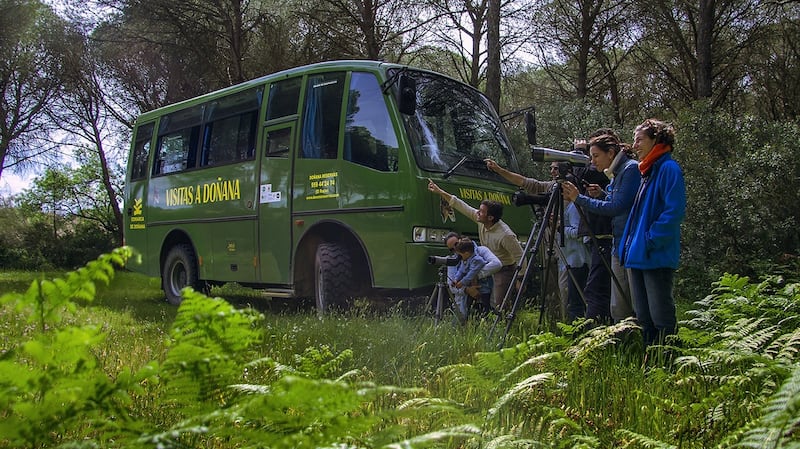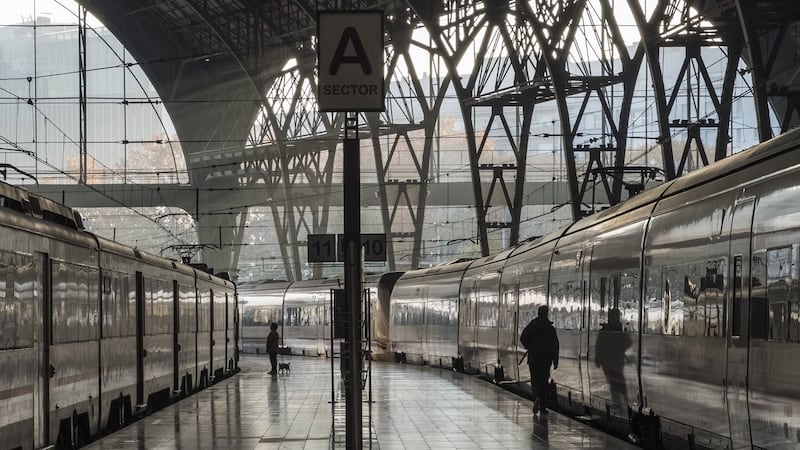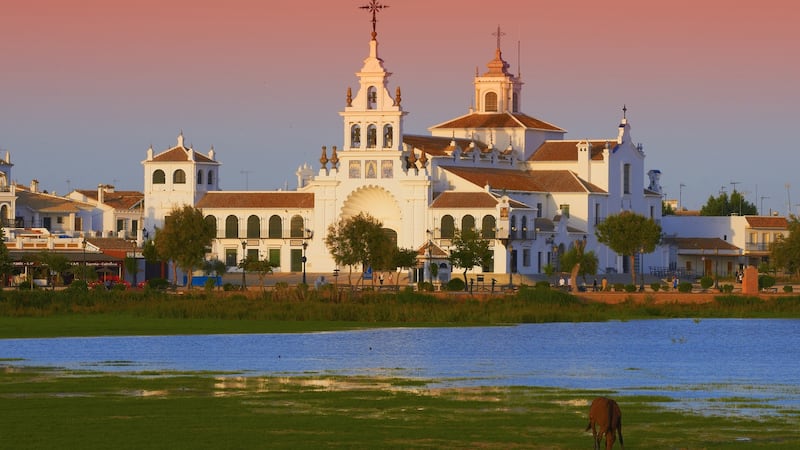Imagine if one of the richest wildlife areas in Europe was just next to the most popular foreign destination for Irish tourists. Wouldn't that be something? Well, it is. It's just that few of us know about Doñana National Park, a 540sq km expanse of marshes, lagoons, woodlands and sand dunes along the Guadalquivir river. It's northwest of the Costa del Sol where a large majority of the two million Irish people who visit Spain each year tend to congregate. Think of that, two million people, roughly a quarter of the population of Ireland, visit Spain each year. Or at least they did, pre-Covid, and most returned year after year to the same spots on the Costa del Sol, the Canaries and the Camino del Santiago route, but somehow we never get to hear about Doñana.
This hot spot for wildlife is renowned among naturalists and birders in Britain, Germany and Scandinavia as the wildest place in Spain, a total outlier and exception on the Iberian Peninsula; but for most Irish tourists, sunbathing and adventure activities take precedence over nature-watching. To give an idea of quite how exceptional the area is, it boasts the highest diversity of birdlife in Europe, with about 300 species coming to breed from Africa or to over-winter from northern Europe – or just passing through. It also has the greatest number of amphibious species in Europe, as well as 15 different types of mammals, from wild boar to whales, as well as one of the most endangered felines on Earth, the Iberian lynx, which looks like a small pointy-eared leopard.
In short, it is a unique ecosystem whose location between two continents and two oceans has gifted it with an enviable diversity of habitats, including pristine wetlands, primary woodland of cork oak and wild olive, estuary lagoons, coastline and sand dunes, both shifting and static. It's a Unesco biosphere reserve and a Unesco World Heritage site, and its 38km of pristine beaches represent one of the few large stretches of undeveloped coastline remaining in Spain. This haven for the Spanish imperial eagle, the white-headed duck, and marble teal has one of the largest heronries in the Mediterranean region and is the wintering site for more than 500,000 waterfowl.

To visit Doñana you first go to the tiny town of El Rocío, 70km east of Seville, which looks like a wild west outpost, with sand roads, colonial verandas and hitching posts outside most buildings, as horses are more numerous than cars here for parts of the year. El Rocío has been the centre of an enormous pilgrimage for 800 years and it still attracts a million horse riders and cattle drovers from all over Spain each year.
I only heard about the region in 2019, just after I had decided to give up flying for holidays, and so I had no choice but to embark on a three-day train journey if I wanted to see what I was told was “undoubtedly one of the most extraordinary landscapes on the European continent”.
My adventure started with a beautiful sunrise sailing from Dublin Bay last January on the 8am Irish Ferries WB Yeats ship. By 4.30pm I was in London, having travelled along the Welsh coastline listening to mellifluous Welsh being spoken all around me in the carriage. It was a five-minute walk from Euston Station to Saint Pancreas, where I hopped on a Eurostar to Paris, and was enjoying dinner in a bistro near the Gare du Nord by 9.30pm. Now, that's how to start an adventure.
Next morning, after a croissant and café au lait at a pavement bar, I walked for 50 minutes along Boulevard de Magenta, past Place de La Revolution and Place Bastille, to Gare du Lyon, leaving enough time to order a baguette filled with local cheeses and salads from a boulangerie for my 6½-hour journey to Barcelona. My seat was sumptuous and well appointed, but I spent much of the trip standing up in the dining car mesmerised by the ever-changing landscape speeding by at 250km/h; from pastoral, hilly fields to sandy rolling plains with red-tiled farmhouses and old stone barns, to vineyards and plantations of plums and apricots further south. Crossing between France and Spain we passed through luminous wetlands bordering the Mediterranean and white-foaming waves lapped at the tracks.

I arrived in Barcelona in mid-afternoon and headed straight to Playa Bogatell for a bracing swim, then roamed the city for a few days, taking in the sights and the winter warmth. The great revelation for me was the sheer beauty of the Estació de França, the old terminus for international trains that was used until the arrival of high-speed daytime TGVs put an end to the old overnight “trenhotels” in 2013. This sumptuous spectacle of wrought iron has a curved glass and metal canopy soaring over 12 tracks that fills the area with natural light. The neoclassical lobby of marble, bronze and hardwood panelling is now largely abandoned, with most international trains arriving into a modern underground station.
It was a further 5½-hour journey to Seville, watching the grip of winter retreat as we sped southwards at 300km/h, with more vibrancy visible in the vines and fruits trees that lined the route, until eventually the landscape opened up into hilly groves of olive trees and solar panels, and then finally the orange-laden slopes on the approach to Seville. I walked from the station through the narrow, medieval streets lined in sweet-scented oranges that were falling from the trees in perfect ripeness, heading towards an old pension where a courtyard room decorated in 19th-century tiles cost €18 for the night.

I took a few days to explore Seville before taking a bus up through the stone pines and strawberry farms to El Rocío. After a week of torrential rain, the sandy streets had been washed away, leading to craters and chasms between the colonial houses and stables which made the place look even more otherworldly. The only walkable track was a brick-lined trail around the vast lake that represents the beating heart of the Doñana marismas (wetlands). The sound of the countless waterfowl reverberating from the expanse of bright water was so mesmerising that, without even leaving my bag in the hotel, I set off walking around the wetlands and out along a boardwalk trail from La Rocina that extended through the indigenous Mediterranean forest. It's like no forest you've ever imagined, as it's barely 1m tall and consists of tough shrubs of sage-leaved rockrose, rosemary, wild olive and mastic, which, though stunted, still manage to shelter a rich array of wild boar, deer and even lynx.
In such an environmentally sensitive area I decided it best to book my travel arrangements through Spain's sustainable tourism organisation, Ecotourism Club (ecotouristinspain.com) which works exclusively with companies who contribute to the conservation of biodiversity in protected regions. It found me a light-filled room overlooking the marsh for €40 a night in the Hotel Toruño which has impressive sustainability credentials, and also booked me on to a private five-hour tour with Doñana Reserves (donanareservas.com), which costs €60pp for up to eight people, but because I was alone I paid a bit more. There were cheaper group tours available, but in such an ecologically complex area I wanted to get as close as possible to the different habitats in a responsible way and have an expert explain them to me.
It was money well spent, as my guide, Javier, gave me an incredibly rich insight into the history, culture, biodiversity and folk traditions of Doñana, as well as the complex challenges the area now faces in terms of balancing development with conservation. For me this region is on a par with anything on the African savanna in terms of beauty and complexity. It's three-quarters the size of Louth or Carlow, and yet is restricted to walkers, cyclists and riders, apart on from on three days each year where pilgrims with horses, mule wagons, oxen, donkeys and cattle pass through along a single fenced corridor. Where else can one come across such a vast area that no humans may drive through, apart from the rangers and a few select guides? Maybe, the best way of describing Doñana National Park is that it's worth travelling three days south and another three days north to experience it.
Getting there: Dublin to London with Irish Ferries (irishferries.com) €96. London to Paris return with Eurostar (eurostar.com) €149. Paris to Barcelona with SNCF (SNCF.com) €158. Barcelona to Seville return with Renfe (renfe.com) €148. Total cost €551.









